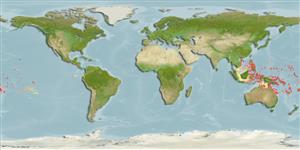Classification / Names
Common names from other countries
Main reference
Size / Weight / Age
Max length : 2.1 cm SL male/unsexed; (Ref. 1602)
Environment
Marine; reef-associated; depth range 0 - 37 m (Ref. 86942)
Climate / Range
Tropical, preferred ?; 19°N - 23°S
Distribution
Western Pacific: from Indonesia, the Philippines, and Palau; south to Australia (Great Barrier Reef and NSW); east to Fiji, Solomon Islands, New Caledonia, Tonga, and the Samoan Islands.
Countries | FAO areas | Ecosystems | Occurrences | Introductions
Short description
Dorsal
spines
(total): 7;
Dorsal
soft rays
(total): 8-10;
Anal
spines: 1;
Anal
soft rays: 7 - 8. This species has a cephalic sensory-canal pore system lacking IT and POP pores; branched pectoral-fin rays branched; dorsal/anal-fin formula 9/8; with the fifth pelvic-fin ray 70% of the fourth ray (Ref. 107299).
IUCN Red List Status (Ref. 115185)
Threat to humans
Harmless
Human uses
More information
Common namesSynonymsMetabolismPredatorsEcotoxicologyReproductionMaturitySpawningFecundityEggsEgg development
ReferencesAquacultureAquaculture profileStrainsGeneticsAllele frequenciesHeritabilityDiseasesProcessingMass conversion
Tools
Special reports
Download XML
Internet sources
Estimates of some properties based on models
Phylogenetic diversity index
PD50 = 0.5000 many relatives (e.g. carps) 0.5 - 2.0 few relatives (e.g. lungfishes)
Trophic Level
3.1 ±0.3 se; Based on size and trophs of closest relatives
Resilience
High, minimum population doubling time less than 15 months (Preliminary K or Fecundity.)
Vulnerability
Low vulnerability (10 of 100)
Price category
